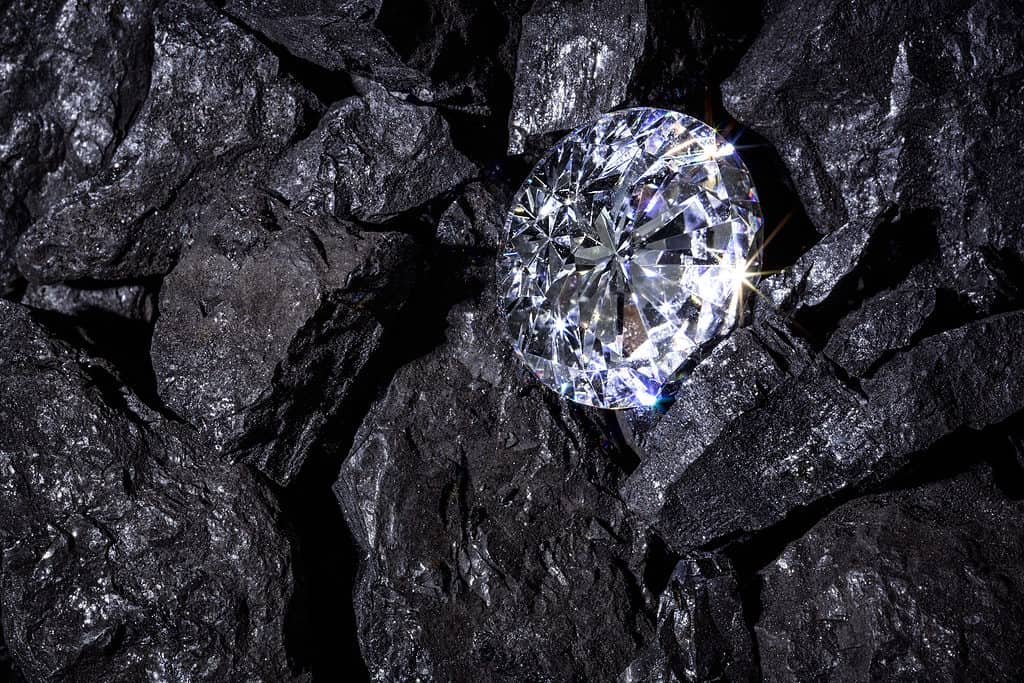Few objects in nature attract as much attention as diamonds. At its core, a diamond is simply a solid form of carbon arranged into a diamond-shaped crystal. However, these rare gems are among the most coveted stones in the world. Experts evaluate diamonds based on their cut, color, quality, and size. The average diamond measures about as large as the head of a match. However, some diamonds can develop into huge gemstones. These especially large gems can fetch hefty sums on the open market. So, what is the largest diamond ever found in the United States? Keep reading to learn about Uncle Sam, the largest diamond found in the U.S.
How Diamonds Form

Over time, carbon and other minerals combined together to form diamonds, like the Uncle Sam diamond found in 1924.
©RTimages/Shutterstock.com
Before we discuss the largest U.S. diamond, let’s first take a moment to explore how diamonds form. Most diamonds in existence formed hundreds of millions of years ago. In fact, the oldest dated diamond measured over three billion years old. Back when the Earth was still young, our world was a swirling mass of molten rock. As it cooled, the intense heat and pressure formed the diamonds found today. The majority of diamonds formed in the mantle, 100 miles below the Earth’s surface. At this depth, temperatures and pressures could exceed 2,000 degrees Fahrenheit and 725,000 pounds per square inch, respectively.
Over time, carbon and other minerals combined together to form diamonds. However, the diamonds remain trapped under hundreds of miles of rock. Luckily, the Earth has a unique method of transporting diamonds closer to the surface, volcanoes. Volcanoes located deep beneath the Earth generate incredible amounts of pressure. Eventually, these volcanoes erupt and push tides of magma (and diamonds) up volcano pipes toward the surface. Most diamonds are found in kimberlite or lamproite, igneous rocks formed from cooling magma. Mining operations aim to find these deposits in the hopes of uncovering the valuable diamonds stored inside.
Uncle Sam: The Largest Diamond Ever Found in the United States
Uncle Sam is the nickname for the largest diamond ever discovered in the United States. The diamond was found in 1924 in Pike County, Arkansas. Back in 1906, a farmer named John Huddleston found two crystals on his farm outside Murfreesboro, Arkansas. Shortly thereafter, Huddleston and his wife sold the farm to a group of investors. Commercial mining soon began on the property, and a diamond boom attracted thousands of prospectors to the area. Private mining operations continued on the property until WWII, at which point the federal government took over the property. After the war ended, the land once again returned to private ownership. For a while, it functioned as a tourist attraction until it again returned to government control. In 1972, the site was renamed Crater of Diamonds State Park. Today, it falls under the control of the Arkansas Department of Parks and Tourism.
The Uncle Sam diamond gets its name from Wesley Oley Basham, the worker who found the diamond. According to legend, Basham went by the name “Uncle Sam,” hence the diamond’s nickname. Back in 1924, Basham worked for the Arkansas Diamond Corporation, which owned a portion of land in the south of what is now Crater of Diamonds State Park. One day, Basham was at work spraying the ground with a hydraulic hose. All of a sudden, he saw a bright flash of light. He knew immediately it was a diamond and drew the attention of other workers. According to bystanders, he yelled out, “Y’all watch out, a big one’s coming!” Little did “Uncle Sam” know that the diamond he found would rank as the largest ever found in the U.S.
How Big Is Uncle Sam?
When uncut, the Uncle Sam diamond weighed 40.23 carats. At 200 milligrams per carat, that means Uncle Sam weighed just over 8 grams. For reference, the average diamond found in the U.S. measures just 1 carat.
Shortly after its discovery, the Arizona Diamond Corporation sold the diamond to Tom Cochran, vice president of J.P. Morgan. Upon Cochran’s death, the diamond was passed to Ernest Schenck. A New York-based diamond cutter, Shenck cut the stone twice. Upon completion, the now-emerald-shaped Uncle Sam diamond measured 12.42 carats. Overall, the diamond looks faintly yellow but can also appear white or pinkish. It also appears extremely clear. It possesses so few impurities that even skilled experts cannot easily find them.
What is the Biggest Diamond in the World?
The largest diamond in the world is the Cullinan Diamond. Even when compared to a large diamond like Uncle Sam, the Cullinan Diamond appears gigantic. When uncut, it weighed an incredible 3,106.75 carats, or 1.33 pounds. In terms of size, it measured 10.1 by 6.35 by 5.9 centimeters long.
Frederick Wells discovered the Cullinan Diamond at the Premier Mine in Pretoria, South Africa. Meanwhile, the diamond gets its name from Thomas Cullinan, the owner of the mine. Eventually, the diamond ended up as a gift to King Edward VII of the United Kingdom. However, in its uncut state, the stone measured too large to display. King Edward sent the diamond to Joseph Asscher & Co. in Amsterdam. The jewelers at Asscher & Co. cut the Cullinan Diamond into nine smaller stones, Cullinan I – Cullinan IX. The largest of these stones, Cullinan I, also goes by the name the Great Star of Africa and weighs 530.2 carats.
Visiting Uncle Sam Sherman
After Ernest Schenck’s death, Uncle Sam passed through several hands. It was owned by Peikin Jewelers in New York and then by Boston diamond dealer Sidney de Young. Sometime after 1971, de Young sold the diamond to an anonymous private collector for $150,000. No one knew the whereabouts of the diamond for the next 50 years.
In 2022, the diamond reappeared when Peter Buck purchased it and donated it to the Smithsonian Museum of Natural History. Today, you can see the stone at the museum. It resides next to the Canary Diamond, an uncut stone that also hails from the Crater of Diamonds State Park.
Where is the Crater of Diamonds State Park Located on a Map?
Crater of Diamonds State Park is a 911-acre Arkansas state park in Murfreesboro, Pike County. There is a plowed field where visitors can search for diamonds, which have continuously been discovered in this field since 1906. The park is actually a volcanic pipe that is part of a 95-million-year-old eroded volcano.
The photo featured at the top of this post is © Bjoern Wylezich/Shutterstock.com
Thank you for reading! Have some feedback for us? Contact the AZ Animals editorial team.







